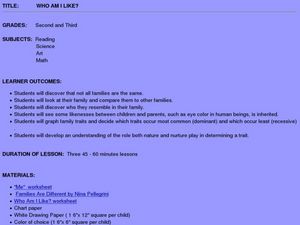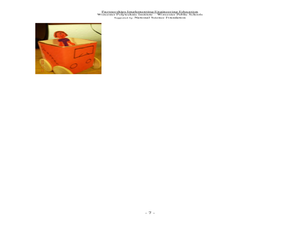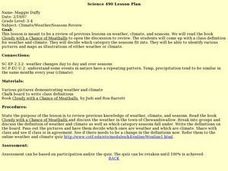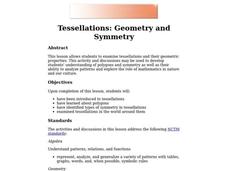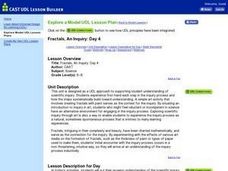Curated OER
The Great Food Hunt
Students locate 'animals' in various environments and draw conclusions about the survival value of structures the animals possess. They create model macaroni animals and hide them and other teams of students find them and evaluate the...
Curated OER
Primate Classification 2006
Learners examine groups of hierarchy and see how primates are categorized. In this primate classification lesson students view video and slides then examine the taxonomy of primates.
Curated OER
Who Am I Like?
Young scholars examine family structures. In this family structure activity, students discover things about their own families and those of their classmates. They make a chart as they discuss nature versus nurture, complete a worksheet...
Curated OER
Building a Car: Mechanical Engineering
Students use common materials to build a car. In this car building mechanical engineering lesson, students build a car using a milk cartoon and plastic wheels. They discuss what mechanical engineers do and what makes a car run.
Curated OER
Galileo's Battle for the Heavens
Young scholars view a video about Galileo's discoveries. They work together to create graphs showing the current sunspot cycle. They discuss how sunspots can cause communication devices problems.
Curated OER
How Machines Help Us Stay Healthy
Students visit different departments at a local hospital to see how machines help peoples such as the CAT scan machine. They build a model of such a machine that shows how patients are moved in and out of the machine.
Curated OER
Principles Of Flight: Wings That Spin
Young scholars discover how flight is possible. In this physics lesson, students investigate the properties of a blimp and gyro-copter, comparing rotating wings and fixed wings of aircraft. Young scholars create their own model...
Curated OER
Animals Finding Rice Paddies
Fourth graders examine the animals who live in rice paddies and create a chart. For this rice lesson, 4th graders link the types of animals living in each ecosystem with a bar graph. Students use colored bars to show animals that live...
Curated OER
Integrating Art Into Other Content Areas
Here are some ideas to help add an art lesson to every math, science, social studies, or language arts unit.
Curated OER
Climate Weather Seasons Review
Students review the concepts of weather, climate, and seasons. They read and discuss a book about weather. Students collaborate on a class definition for climate and weather. They match weather to the specific season. Students...
Curated OER
Can We Be Both Conservationists and Consumers?
High schoolers explore their role as consumers and conservationists and what roles they play in today's economic climate. They explore resource allocation issues. Students analyze data and draw comparisons between historical and...
Curated OER
How Has Transportation Changed Since the 1899 Harriman Alaska Expedition?
Students recognize modes of transportation. They research historical data from a variety of primary and secondary sources including the Harriman expedition journals, related web sites, and photographs from the expedition. Students...
Curated OER
The Sahara: Home of the Tuareg
Students study inhabitants of the Sahara. In this Tuareg culture lesson, students explore the how the Tuareg people adapt to their environment as they research specific Internet sites.
Curated OER
When Clay speaks
Learners listen as the teacher reads "When Clay Sings," by Byrd Taylor. They discuss clay, and view a variety of clay items. Students watch a video clip "Interests in One of a Kind Pots." They watch a demonstration on working with clay....
Teach Engineering
What Does Light See?
The second installment of a seven-part series focuses on the refraction of light and how it affects the colors we see. Learners consider how this concept connects to biosensors for cancer detection.
Orange County Water Atlas
Location, Location, Location…
Young geographers discover not only how to read and recognize coordinates on a map, but also gain a deeper understanding of latitude and longitude and how climate changes can vary significantly across latitudes.
Curated OER
Predicting Lunar Eclipses
Students explore lunar eclipses and discover how to predict an eclipse the same way that ancient people did. They examine dates of recorded eclipses and find a pattern. Students apply an algorithm to the pattern.
Curated OER
Tessellations: Geometry and Symmetry
Students examine tesselllations and their geometric properties. They have a better knowledge of polygons, can identify types of symmetry in tessellations. Also students use visulization, spatial reasoning, and geometric modeling to...
Curated OER
It Counts
Students explore one to one number correspondence. In this early math lesson, students make observations about and classify plants in order to gain an understanding of using numbers to describe their world.
Curated OER
Tessellations
Students identify shapes that will tessellate. They construct a tessellation using transformations. Students identify transformations in tessellations. They identify applications of transformations such as tiling and fabric design.
Curated OER
The Great Fossil Find - Reconstructing the Pieces
Students go on an imaginary fossil hunt. They follow a script read by the teacher, students "find" (remove from envelope) paper "fossils" of some unknown creature. They attempt to reconstruct fossil pieces into an animal.
Curated OER
Fractals, An Inquiry: Day 4
Students put their growing understanding of the scientific inquiry process to work. They use paint to implement their plans to experiment with how changing one aspect of the fractal making process influences their appearance.
Curated OER
Pliable Proteins
Students make models of protiens using wire and paperclips. They are given step by step instructions with lots of information about proteins throughout the directions. They make the three basic structual elements of proteins;...
Curated OER
Sound Portraits
Students observe a variety of sounds which can be heard within their schoolyard habitat by sitting quietly by themselves for five minutes, listening, and then recording the sounds around them by drawing them.




